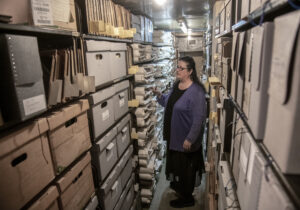
PROVIDENCE – A year after being expelled from Massachusetts Bay Colony in 1636, Rhode Island founder Roger Williams was still communicating with the more moderate leaders of the religiously conservative colony, including co-founder John Winthrop.
A handwritten note to Winthrop from Williams on now faded and browning parchment details a financial dispute he mediated in the newly founded Providence Plantations between a native “sachem,” or chief, and a group of Englishmen over hunting traps and the loss of some horses.
“They conceave it would be very faire and honourable in all Natives eyes yt it would please the English to make knowne as well their moderation as their Justice in ye case,” wrote Williams, a minister remembered today for his advocacy of religious freedom and fair treatment of 17th-century Native Americans.
The letter brings Williams and the day-to-day challenges of Rhode Island’s founding to life, though few people outside of researchers know of its existence. It’s one of thousands of historical records, photographs, film, and other business-related relics collected and archived at the Rhode Island Historical Society’s Mary Elizabeth Robinson Research Center.
The center serves as the clearinghouse for 100,000 volumes of material related to the history of Rhode Island and New England, including 1,000 manuscripts, 200,000 images, 9 million feet of film, 19,000 prints, 3,400 sound recordings and 20,000 architectural drawings.
Business and financial records, including Williams’ letter, make up about one-third of the nonprofit’s collection, including vast volumes of merchant records, maritime logs, personal correspondence and inventories.
The research center was a public library until the society purchased it in 1961. Visitors enter a cavernous reading room, its shelves and filing cabinets almost reaching the ceiling. They can peruse ledgers, filing cabinets and labeled boxes that show both the minutia of business expenses and offer insight into the state’s wider commercial history.
Materials span five centuries and include records from many of the state’s most successful entrepreneurs and benefactors, such as the Brown family and shipping merchant Edward Carrington.
It can be a lot to process even for those who work there, said Richard Ring, the society’s executive director of collections and interpretations. He joined the organization in 2017.
“It’s hard to even wrap your head around the whole landscape,” he said.
Take, for example, the records of The Providence Tool Co,, at one time the city’s largest single employer. The center has company material from 1844-1945. The now-shuttered company “manufactured a wide range of tools and machinery” before the Civil War and helped supply the Union Army, said associate director Phoebe Bean.
Bean has always had a passion for preservation. She has worked for the society for two decades and has witnessed many document hunters hit pay dirt.
“We see a lot of goosebumps,” she said. “It happens every day.”
Among Bean’s favorites are the accounts and ledgers kept by John Carter, an apprentice to Benjamin Franklin and the owner of the Providence Gazette. He was also the city’s first postmaster.
“These ledgers provide the specific details of his daily life as a printer and bookseller,” said Bean. “[There are] accounts of local customers listed, payments for supplies, orders for books to be printed.”
The center also has a vast microfilm archive of every Rhode Island newspaper going back to 1732.
Its most recent acquisition is a collection of records from Rumford Chemical Works Co., a major industrial presence in Rhode Island for over a century before relocating to Indiana, where years later their records were abandoned in a warehouse in Terra Haute.
As luck would have it, the society already had about 600 ledger books and photographs relating to Rumford Chemical before the abandoned records were donated.
When the society takes possession of new materials, most of which is donated by former owners or their family members, Ring jokingly likens the relationship to a marriage.
“We promise to love, honor and preserve,” he said.

PBN PHOTO/MICHAEL SALERNO
Whether an academic, amateur genealogist or professional historian, there is a treasure trove of materials for anyone interested in the Ocean State’s commercial history. Most of the library’s visitors are researchers and academics. The society has assisted media productions, such as Ken Burns’ acclaimed multipart series on the Civil War. And more recently, they helped the producers of the hit podcast “Crimetown,” which focused on Providence’s underworld and its connections to City Hall.
“People think of us as the attic of the state,” said Ring, “or the evidence room.”
The nonprofit is funded through a combination of state and federal grants, membership dues and admissions, a network of private donors and a $22 million endowment.
The organization has worked to digitize records as time and funding allow. Its most recent project was the digitization of records from the Old Stone Bank, one of Rhode Island’s oldest financial institutions, including depositor records from the bank’s founding in 1819 through 1897.
Ring said it’s a common misconception that physically archived materials are less secure than digital forms. But this is not the case, as even digital files can degrade over time.
“Paper is still the most stable archival medium that we know,” he said.
While many of the companies listed in the business collection are a distant memory, some are still operating locally. One example is the Providence Mutual Fire Insurance Co., granted its charter by the General Assembly in 1800 and now in Warwick. This collection consists solely of insurance policy books dating from 1807 to 1857.
 The business records are in many ways a living collection. In 2018, the society acquired over 1,000 drawings and business correspondences of the late Newport architect Richard Long, who served as principal architect for the Newport Restoration Foundation.
The business records are in many ways a living collection. In 2018, the society acquired over 1,000 drawings and business correspondences of the late Newport architect Richard Long, who served as principal architect for the Newport Restoration Foundation.
With advance notice, society staff can locate materials by request. With the reams of materials taking up two stories of space above the reading room, it helps to know what you’re looking for.
Though well-versed in Rhode Island history, society staff are not researchers themselves. Rather, they are archivists, or as Ring put it: “the stewards.”
“We create pathways for other researchers,” he said. “We collect and arrange so that others can study.”
IF YOU GO:
What: Rhode Island Historical Society’s Mary Elizabeth Robinson Research Center
Where: 121 Hope St., Providence
When: Open for reference walk-ins Wed. 1 p.m. -7 p.m., Thurs- Fri. 1 p.m.-4 p.m. and 10 a.m.-1 p.m. on the second Saturday of the month. Manuscript viewing by appointment. Email: reference@rihs.org
Cost: no charge.
(Christopher Allen is a PBN staff writer. You may contact him at Allen@PBN.com)










